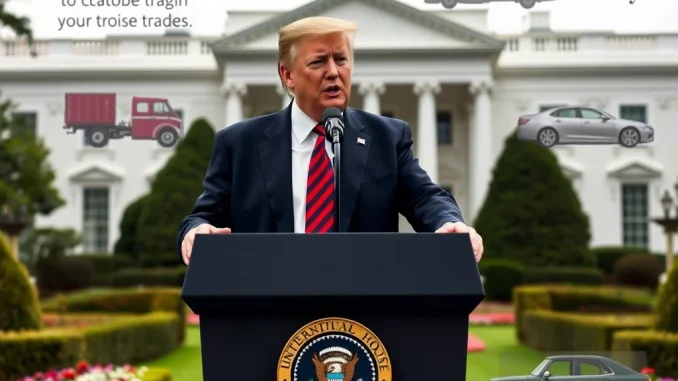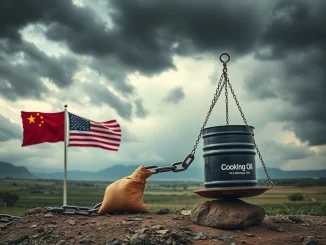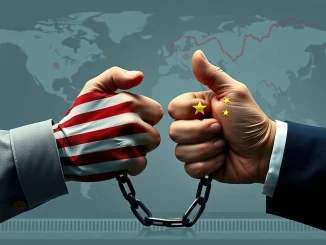
President Donald Trump ignited a firestorm in global trade relations with a forceful speech delivered from the White House Rose Garden. His remarks centered on what he termed ‘reciprocal tariffs,’ zeroing in on trade imbalances and specifically calling out South Korea’s auto imports and tariffs imposed by several nations on American goods. Let’s delve into the specifics of Trump’s statements and explore the potential ramifications of his tariff policies.
Unpacking Trump’s Tariff Criticism and Korean Auto Imports
During his address, President Trump highlighted the automotive industry, a sector often at the forefront of trade discussions. He asserted that a staggering 81% of Korean cars imported into the United States are actually manufactured in Korea itself. This statistic, according to Trump, underscores a trade dynamic where American consumers are heavily reliant on foreign-made vehicles from Korea. He framed this as a point of concern, suggesting an imbalance in the trade relationship. But what does this really mean for the average person and the broader economy?
Key Points from Trump’s Speech on Korean Auto Imports:
- 81% of Korean Cars Imported are Korean-Made: Trump emphasized the high percentage of Korean-manufactured cars entering the US market, implying a lack of reciprocity in automotive trade.
- Reciprocal Tariffs: The speech was themed around ‘reciprocal tariffs,’ suggesting that the US should impose tariffs on countries that levy high tariffs on American goods.
- Focus on Trade Imbalances: Trump’s comments are part of a broader narrative focused on reducing trade deficits and ensuring fair trade practices for the United States.
The 50% Tariff Claim on US Rice: Is it Accurate?
A particularly striking claim made by President Trump was that Korea ‘effectively imposes a 50% tariff on U.S. rice.’ This statement raises questions about the specifics of agricultural trade barriers and whether such a high tariff is indeed in place. While the exact figure might be debated, it’s crucial to understand the context. Agricultural tariffs and non-tariff barriers are often complex, involving quotas, sanitary regulations, and various other measures that can impact market access. Let’s examine this further:
Understanding Potential Trade Barriers on US Rice in Korea:
| Factor | Description |
|---|---|
| Tariff Rate Quotas (TRQs) | Korea, like many countries, might employ Tariff Rate Quotas for rice. This system allows a certain quantity of rice to be imported at a lower tariff rate, while imports exceeding the quota face significantly higher tariffs. This system can effectively create high barriers for imports beyond the quota. |
| Non-Tariff Barriers | Beyond explicit tariffs, other measures can restrict trade. These include stringent sanitary and phytosanitary regulations, import licensing procedures, and complex customs processes. These can add costs and hurdles for US rice exporters. |
| Domestic Support Policies | Korean government policies supporting domestic rice farmers can also indirectly impact the competitiveness of imported rice. Subsidies and price support mechanisms can make domestically produced rice more attractive to consumers. |
It’s important to note that trade policy details are often nuanced, and the ‘50% tariff’ figure might be a simplified representation of the overall trade barriers faced by US rice exporters in the Korean market. Further research and official trade data are needed for a precise understanding.
Beyond Korea: Trump’s Broader Trade War Concerns
President Trump’s tariff criticism extended beyond Korea. He also pointed fingers at Thailand, Vietnam, and India, asserting that these nations maintain ‘high tariffs’ on U.S. products. This broader critique signals a wider concern about trade imbalances and what the Trump administration perceives as unfair trade practices across multiple countries. This raises significant questions about the future of global trade and the potential for escalating trade tensions, possibly even a full-blown trade war.
Countries Called Out by Trump for High Tariffs:
- Thailand: Criticized for maintaining high tariffs on various US goods. Specific sectors were not detailed in the provided content, but likely encompass agricultural products and manufactured goods.
- Vietnam: Similar to Thailand, Vietnam was mentioned as having high tariffs impacting US exports. Vietnam is a rapidly growing economy and a significant trading partner for the US.
- India: India, a major global economy, was also included in Trump’s criticism. India’s tariff regime has often been a point of contention in trade discussions with the US.
What are the Potential Implications of Trump’s Tariff Stance?
President Trump’s strong stance on tariffs, particularly his focus on ‘reciprocal tariffs,’ carries significant implications for international trade and the global economy. Let’s consider some potential consequences:
Potential Impacts of Increased Tariffs:
- Increased Consumer Prices: Tariffs are essentially taxes on imported goods. These taxes are often passed on to consumers in the form of higher prices for imported products and even domestically produced goods that face less competition.
- Retaliatory Tariffs: When one country imposes tariffs, affected trading partners often retaliate with their own tariffs. This tit-for-tat escalation can lead to trade wars, harming businesses and consumers on all sides.
- Disrupted Supply Chains: Global supply chains are intricately linked. Tariffs can disrupt these chains, forcing businesses to find new suppliers, potentially increasing costs and inefficiencies.
- Economic Slowdown: Widespread trade wars can dampen economic growth globally. Reduced trade and investment can lead to slower economic activity and job losses in certain sectors.
- Impact on Specific Industries: Certain industries, like agriculture, automobiles, and technology, are particularly vulnerable to tariff disputes and trade policy changes.
Actionable Insights: Navigating the Tariff Landscape
For businesses and individuals alike, understanding the evolving tariff landscape is crucial. Here are some actionable insights:
- Stay Informed: Keep abreast of trade policy developments and announcements from government agencies and international trade organizations.
- Assess Supply Chain Risks: Businesses should evaluate their supply chains to identify potential vulnerabilities to tariffs and explore diversification strategies.
- Advocate for Open Trade: Engage with policymakers and industry associations to advocate for trade policies that promote fair and open markets.
- Explore Market Diversification: Businesses overly reliant on specific export markets should consider diversifying to mitigate risks associated with trade disputes.
- Prepare for Price Volatility: Consumers should anticipate potential price fluctuations for goods impacted by tariffs and adjust their purchasing decisions accordingly.
Conclusion: A Critical Juncture in Global Trade
President Trump’s recent speech underscores a critical juncture in global trade relations. His forceful criticism of tariffs imposed by trading partners and his emphasis on reciprocal tariffs signal a potential shift towards a more protectionist trade policy. While the stated aim is to level the playing field and address trade imbalances, the risk of escalating trade tensions and a full-blown trade war remains a significant concern. Understanding the nuances of tariff policies and their potential impacts is essential for navigating this complex and evolving global trade landscape. The coming months will be crucial in determining the trajectory of international trade and the extent to which Trump’s tariff rhetoric translates into concrete policy changes and ultimately affects the global economy.



